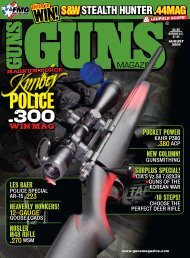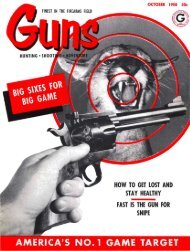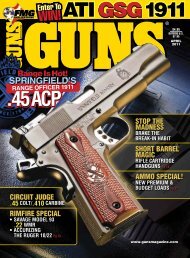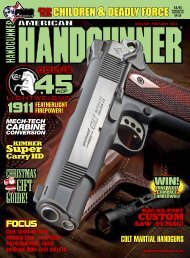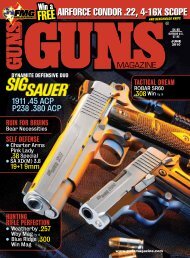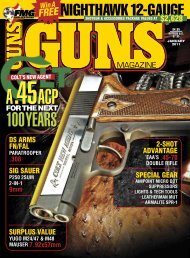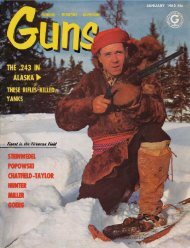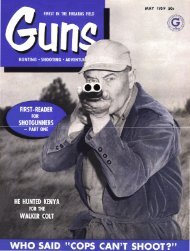GUNS Magazine January 1960 - Jeffersonian
GUNS Magazine January 1960 - Jeffersonian
GUNS Magazine January 1960 - Jeffersonian
Create successful ePaper yourself
Turn your PDF publications into a flip-book with our unique Google optimized e-Paper software.
LOOKING<br />
LONG<br />
FOR<br />
NGE<br />
EFFICIENCY<br />
in aSporter?<br />
~~e'1<br />
III/ Model! .<br />
I<br />
One<br />
Caliber!<br />
O~e L.... OW<br />
PrIce!<br />
I·~,<br />
---,<br />
,I<br />
NORMA 7 x 61 SHARPE &<br />
HART CARTRIDGES loaded to<br />
our specifications are sold exclusively<br />
throuqh Sharpe & Hart Associates<br />
dealers in the U. S.. Canada and Alaska.<br />
Primers are of the American type and are<br />
non~corrosiveand non·mercuric. 160-qrain,<br />
pointed soft-point boallall bullet at a<br />
muzzle velocity of 3100 f.s. and averaqe<br />
pressure of 51.730 pounds.<br />
See your Dealer or order direct.<br />
THE SHARPE &HART ASSOCIATES, INC.<br />
EMMITSBURC 3. MD.<br />
NOTES ON KILLING POWER<br />
AT LEAST SINCE 1912, when the Savage<br />
.t\. Arms Corp. came out with Charles<br />
Newton's revolutionary .22 High Power,<br />
there has been a more or less continuous<br />
argument regarding the relative merits of<br />
high-velocity, small bore bullets and comparatively<br />
slow bullets of greater weight and<br />
calibre. Men of unquestioned integrity and<br />
experience have advocated projectiles of both<br />
types; and many a camp fire has been kept<br />
burning far into the night by sportsmen who<br />
have felt violently on the subject, one way<br />
or the other. Having killed my share of<br />
game in the United States, Canada, Mexico,<br />
and Africa, I am of the sincere opinion that<br />
both factions are right-and that both factions<br />
can be wrong, depending upon conditions.<br />
It might be well to consider just what it is<br />
that kills an animal. Insofar as firearms are<br />
concerned, the thing which kills game is a<br />
bullet which destroys certain vital organs<br />
upon which the life of the animal depends.<br />
Placement of the shot is by far the most<br />
important factor involved. This factor is controlled<br />
entirely by the ability of the hunter,<br />
and there is no substitute for it. There can<br />
be no great argument about this among<br />
thinking sportsmen. The arguments arise in<br />
connection with the best equipment with<br />
which to achieve this objective; and this is<br />
governed by many varying conditions.<br />
In my experience, I have always found<br />
that a high-velocity bullet which actually<br />
reaches a vital area kills far more rapidly<br />
than a slow one regardless of calibre or<br />
weight. I am, therefore, a high-velocity advocate<br />
under conditions where it is reasonable<br />
to assume that such a bullet can and<br />
will reach such an area. Unfortunately, there<br />
are many circumstances wherein such an assumption<br />
would be a monumental error leading<br />
to total misses, wounded game and, quite<br />
conceivably, to actual danger to the hunter.<br />
It seems to me that, among other things<br />
which must be considered, there are the<br />
questions of the size of the animal, the probable<br />
range at which the average shot will be<br />
Laken, the characteristics of the terrain, and<br />
the potential ability of the animal to inflict<br />
damage on the hunter. If, for example, the<br />
desired trophy is a soft-skinned animal<br />
weighing 500 pounds or less, found customarily<br />
in open country where long range<br />
shots are the rule, then a man is justified in<br />
choosing a very accurate, 'scope sighted rifle<br />
of very high velocity. Such a rifle, because<br />
of its accuracy, flatness of trajectory, and<br />
efficiency of sighting arrangements will materially<br />
contribute to a hunter's ability to<br />
pIace his bullet in a vital area.<br />
If, on the other hand, your game is something<br />
on the order of elk as to size, and if<br />
you will be hunting in thick timber, such a<br />
choice would hardly be a happy one. In the<br />
first place, it is probable that you will have<br />
By R. F. CHATFIELD-TAYLOR<br />
to shoot through some brush. In the second<br />
place, it is most likely that your only target<br />
will be the south end of a northbound beast_<br />
Under these conditions, a high-velocity,<br />
spitzer bullet is just about the worst medicine<br />
imaginable, since of all types its performance<br />
is the most unpredictable in heavy<br />
brush. The only guaranteed prediction is that<br />
you cannot predict. Both velocity and spitzer<br />
points mitigate against reliable bullet performance<br />
in brush and, therefore, one would<br />
be wise to choose a relatively large-bore rifle<br />
throwing a round-nosed bullet at not over<br />
2400 ft. secs. and preferably a bit less.<br />
In Africa, one finds just about every condition<br />
conceivable, as well as every size of<br />
game from dik-dik to elephant. The more<br />
experienced white hunters are quite willing,<br />
even anxious, to see you use a flat shooting,<br />
high-velocity weapon on much of the plains<br />
game, since well placed shots on that type<br />
of game are almost always instantly fatal and<br />
since it is easier to make well placed shots<br />
with that kind of rifle over long and unknown<br />
ranges. When, however, the shooting<br />
is done in heavy bush, when the bigger species<br />
such as eland, roan, sable, greater kudu<br />
and zebra are involved or, m(}st particularly,<br />
if the game is of the dangerous variety,<br />
then the white hunters deplore the use of<br />
small-bore, high-velocity rifles and have<br />
been largely responsible for the current laws<br />
in British East Africa prohibiting their use<br />
on dangerous game. There is far too great an<br />
element of chance. A light, fast bullet may<br />
not get through the brush; if it does, it may<br />
be deflected to a non-vital area; and it may<br />
not penetrate through heavy bone and muscle<br />
even if it does strike the proper region. This<br />
is altogether too many "ifs" even for nondangerous<br />
game. For elephant, rhino, buffalo,<br />
and lion, such a rifle is, in my opinion,<br />
unthinkable.<br />
Two extremely experienced hunters have<br />
developed tables of killing power. They may<br />
not give all the answers, but they are very<br />
good yardsticks. Elmer Keith uses a system<br />
based upon what he calls "pounds-feet."<br />
John Taylor, if I am not mistaken, calls his<br />
"K-O Values." Both systems are based upon<br />
bullet weight and velocity, with the accent on<br />
bullet weight. Both of these men are experts,<br />
with lifetimes of experience in the<br />
field, and their comments should not be<br />
taken lightly_ These tables may be found in<br />
Keith's excellent "Rifles for Large Game"<br />
and in Taylor's "African Rifles and Cartridges."<br />
For some time I have been concerned with<br />
another factor which neither Keith nor<br />
Taylor include in their tables, although both<br />
authors make abundant mention of it elsewhere<br />
in their books. This is the question of<br />
sectional density, the formula for which is<br />
W/d 2 wbere W is the weight of the bullet in<br />
(Continued on page 59)<br />
12 <strong>GUNS</strong> JANUARY <strong>1960</strong>




